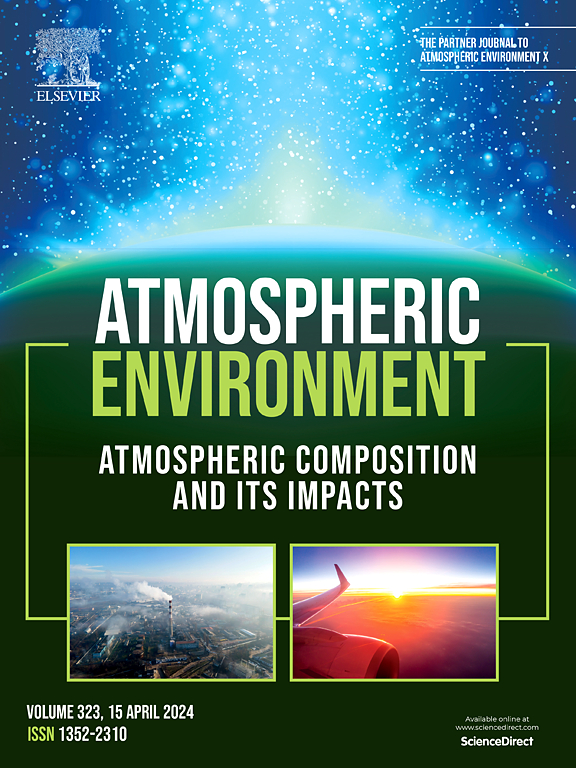Factors influencing the relationships between hourly visibility and aerosol optical depth in China—implications for hourly aerosol optical depth retrievals using automatic visibility observations
IF 3.7
2区 环境科学与生态学
Q2 ENVIRONMENTAL SCIENCES
引用次数: 0
Abstract
Aerosol optical depth (AOD) is a key parameter for evaluating climate change and air quality, yet ground-based AOD observations in China remain limited, and satellite data often suffer from acquisition gaps due to cloud cover. Surface visibility (VIS) offers a promising alternative for AOD retrieval, but the relationship between VIS and AOD is complex and shaped by multiple factors such as meteorological conditions, the vertical distribution of aerosols, topography, and population density. This study systematically explored the influence of these factors on the hourly VIS–AOD relationship, using over ∼2300 automatic VIS measurements and Himawari-8 satellite-retrieved AOD data collected across China from 2016 to 2021. The results reveal significant spatiotemporal variations in the VIS–AOD relationship, with stronger diurnal aerosol fluctuations in eastern China compared to the west, and a consistent inverse correlation between VIS and AOD. The correlation peaks in the late afternoon and reaches a seasonal maximum during winter. These relationships are influenced not only by regional meteorological thresholds but also by constraints from aerosol vertical distribution patterns and geographical conditions. Crucially, adjusting the AOD by incorporating the planetary boundary layer height markedly improves its correlation with VIS, underscoring the importance of daily planetary boundary layer dynamics. These findings offer valuable insights for refining hourly AOD retrieval methods from VIS, thereby enhancing the understanding of aerosol behavior across China.
中国逐时能见度与气溶胶光学深度关系的影响因素对利用自动能见度观测逐时气溶胶光学深度反演的启示
气溶胶光学深度(AOD)是评估气候变化和空气质量的关键参数,但中国的地面AOD观测仍然有限,卫星数据往往受到云层覆盖的影响。地表能见度(VIS)是一种很有前景的AOD反演方法,但VIS与AOD之间的关系复杂,受气象条件、气溶胶垂直分布、地形和人口密度等多种因素的影响。该研究系统地探讨了这些因素对逐时VIS - AOD关系的影响,使用了2016年至2021年在中国收集的超过2300次自动VIS测量和Himawari-8卫星检索的AOD数据。结果表明,大气能见度与AOD的关系存在显著的时空差异,中国东部气溶胶日波动强于西部,大气能见度与AOD呈一致的负相关关系。相关性在下午晚些时候达到峰值,在冬季达到季节性最大值。这些关系不仅受到区域气象阈值的影响,还受到气溶胶垂直分布模式和地理条件的制约。重要的是,结合行星边界层高度调整AOD显著改善了其与VIS的相关性,强调了行星边界层日动力学的重要性。这些发现为改进每小时从VIS中获取AOD的方法提供了有价值的见解,从而增强了对中国气溶胶行为的理解。
本文章由计算机程序翻译,如有差异,请以英文原文为准。
求助全文
约1分钟内获得全文
求助全文
来源期刊

Atmospheric Environment
环境科学-环境科学
CiteScore
9.40
自引率
8.00%
发文量
458
审稿时长
53 days
期刊介绍:
Atmospheric Environment has an open access mirror journal Atmospheric Environment: X, sharing the same aims and scope, editorial team, submission system and rigorous peer review.
Atmospheric Environment is the international journal for scientists in different disciplines related to atmospheric composition and its impacts. The journal publishes scientific articles with atmospheric relevance of emissions and depositions of gaseous and particulate compounds, chemical processes and physical effects in the atmosphere, as well as impacts of the changing atmospheric composition on human health, air quality, climate change, and ecosystems.
 求助内容:
求助内容: 应助结果提醒方式:
应助结果提醒方式:


